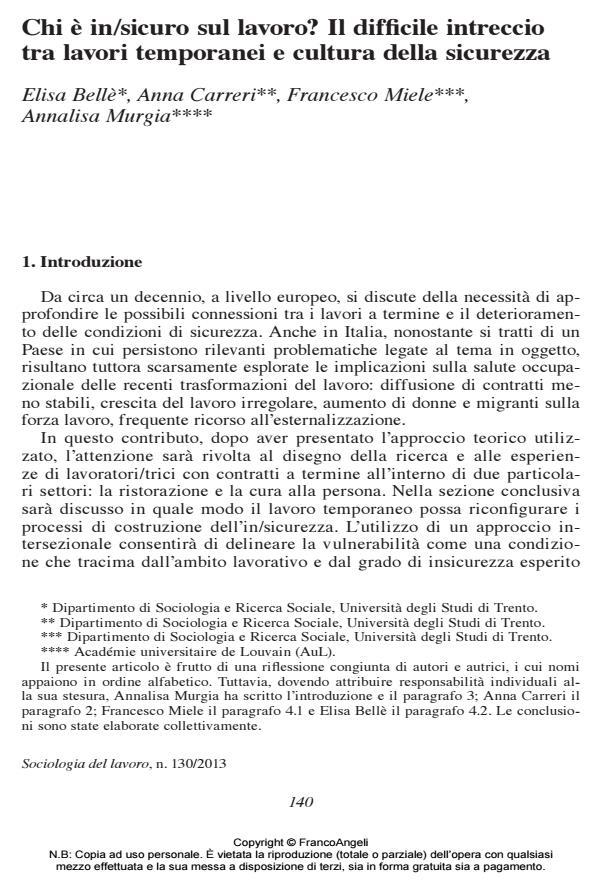Chi è in/sicuro sul lavoro? Il difficile intreccio tra lavori temporanei e cultura della sicurezza
Titolo Rivista SOCIOLOGIA DEL LAVORO
Autori/Curatori Elisa Bellè, Anna Carreri, Francesco Miele, Annalisa Murgia
Anno di pubblicazione 2013 Fascicolo 2013/130
Lingua Italiano Numero pagine 14 P. 140-153 Dimensione file 273 KB
DOI 10.3280/SL2013-130009
Il DOI è il codice a barre della proprietà intellettuale: per saperne di più
clicca qui
Qui sotto puoi vedere in anteprima la prima pagina di questo articolo.
Se questo articolo ti interessa, lo puoi acquistare (e scaricare in formato pdf) seguendo le facili indicazioni per acquistare il download credit. Acquista Download Credits per scaricare questo Articolo in formato PDF

FrancoAngeli è membro della Publishers International Linking Association, Inc (PILA)associazione indipendente e non profit per facilitare (attraverso i servizi tecnologici implementati da CrossRef.org) l’accesso degli studiosi ai contenuti digitali nelle pubblicazioni professionali e scientifiche
L’articolo mira a comprendere in qual modo il lavoro temporaneo porti a riconfigurare i processi di costruzione dell’in/sicurezza nei luoghi di lavoro. A questo scopo il contributo si sofferma su alcune delle interviste svolte nell’ambito di una ricerca inerente le relazioni tra condizioni di sicurezza e lavoro temporaneo nei settori della cura e della ristorazione. Viene in primo luogo messo in evidenza il fatto che ad impedire l’apprendimento di modi di lavorare sicuri sia l’intrecciarsi della temporaneità contrattuale con altri elementi di vulnerabilità, quali ad esempio lo scarso livello di esperienza o la condizione di migrante. In secondo luogo, l’articolo mostra come quest’insieme di elementi porti i soggetti che lavorano con contratti a termine a dover apprendere come muoversi all’interno di ambienti in/ sicuri, facendosi dunque carico dei costi della sicurezza, o addirittura a dover trascurare del tutto la propria salute lavorativa, delineando, quindi, delle vere e proprie "carriere vulnerabili".
Parole chiave:Lavoro temporaneo, salute lavorativa, cultura della sicurezza, intersezionalità
Elisa Bellè, Anna Carreri, Francesco Miele, Annalisa Murgia, Chi è in/sicuro sul lavoro? Il difficile intreccio tra lavori temporanei e cultura della sicurezza in "SOCIOLOGIA DEL LAVORO " 130/2013, pp 140-153, DOI: 10.3280/SL2013-130009